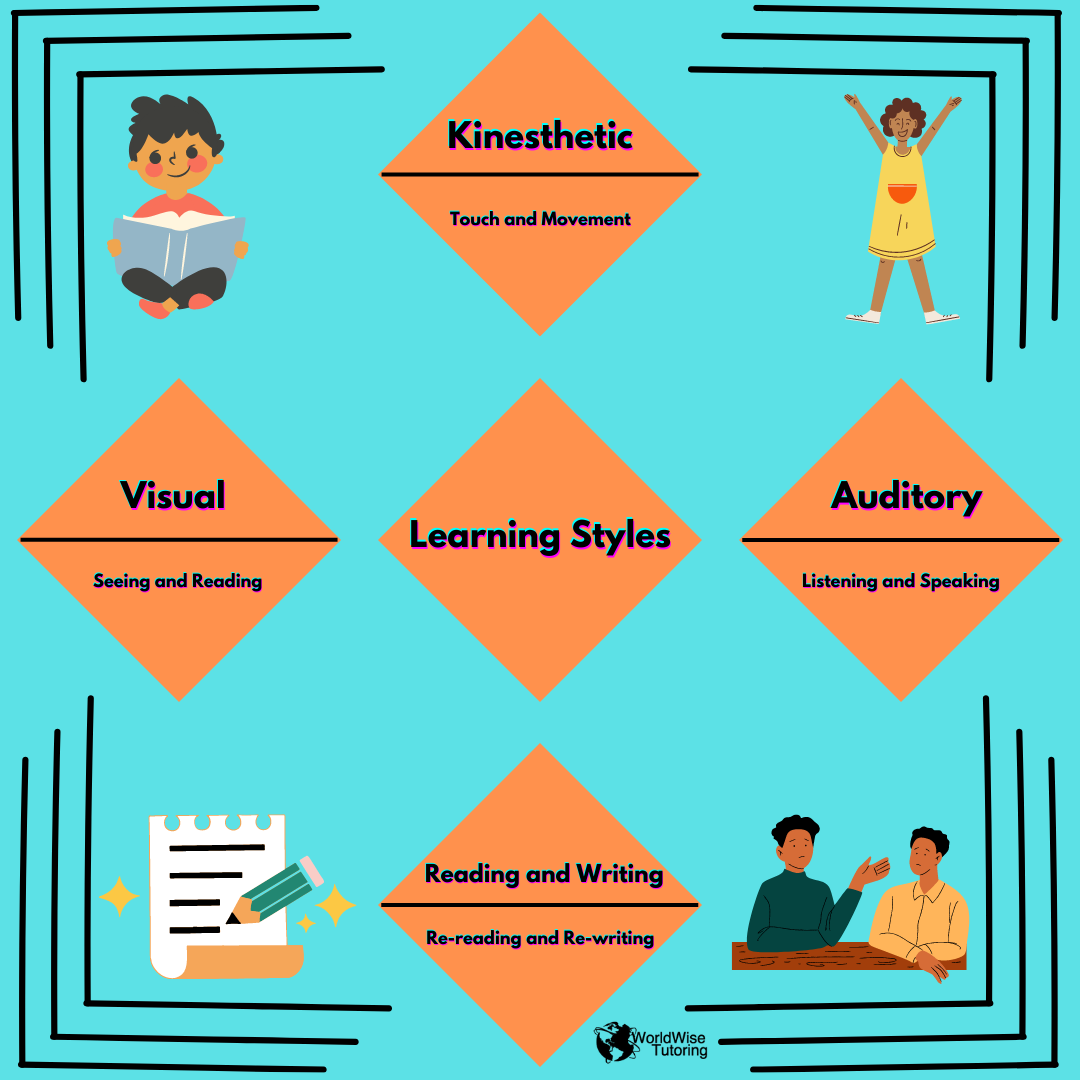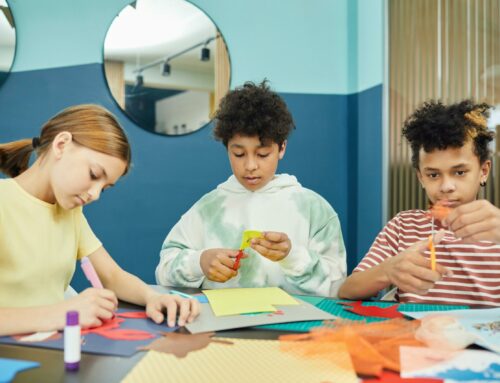Identifying learning styles is a simple way to personalize education. Knowing your dominant learning style(s) will help you better adjust to various learning environments, teaching techniques, and content delivery methods. You may be primarily a visual, auditory, kinesthetic, and reading/writing learner – or even a combination of 2 or more. This article will help you determine your likely learning style(s) and how to utilize that information to elevate your learning abilities.
Benefits of Identifying Your Learning Styles
Identifying your dominant learning style is essential for your academic performance and self-development. This powerful knowledge can lead to meaningful self-reflection regarding your strengths and struggles, allowing you to improve further. For instance, maybe you notice that you have been having trouble in your chemistry class where your teacher mostly gives lectures. When you know that you are weakest in the auditory learning style but strongest in the kinesthetic learning style, you can take it upon yourself to supplement your school lessons with hands-on projects to deepen your understanding in a way that works best for you. You can even share some of your most effective experiments with your class to help other visual and kinesthetic learners. Essentially, arming yourself with knowledge about your personal learning preferences will allow you to capitalize on your natural talents to succeed in any situation.
It is important to note that people often have two or even three dominant learning styles at any one time, depending on their stage in life and current challenges. Also, preferred learning styles tend to change throughout one’s life as new experiences are gained and a better understanding of oneself is achieved. So while it is beneficial to think about your learning style, know that this is not an exact black-or-white science but something that can change depending on the circumstances. That, in itself, makes this an even more unique topic that is worth investigating.
Kinesthetic Learners
Kinesthetic learners often flourish with physical movement and hands-on experiences. For example, building a functioning science model or acting out a scene from history allows kinesthetic learners to feel what they are learning, thereby deepening their understanding. Signs of a kinesthetic learner can include the enjoyment of working with one’s hand, physical activities, and building projects. Those with a dominant kinesthetic learning style often struggle with sitting still and reading.
Do you show signs of being a kinesthetic learner? These strategies may help:
- Use a fidget tool when you are required to sit still.
- Follow what you read with your finger or pencil.
- Correlate a physical movement with an idea/term.
- Walk while reciting information out loud or in your head.
- Incorporate physical activity breaks into your study routine.
- Role-play with a peer or tutor when studying.
- Teach someone else what you have learned.
Kinesthetic learners often learn best when being active participants in their learning, which bolsters their cognitive, social, and emotional development as well. So if you are a kinesthetic learner, let your strengths shine!
Auditory Learners
Auditory learners understand information best through listening and speaking. For instance, those with a dominant auditory learning style usually prefer listening to a lecture over reading a textbook or hearing the instructions for a project instead of figuring it out hands-on. If you are an auditory learner, there is a good chance you are the kind of person who likes to talk, is able to easily remember names, enjoys music, or is an extrovert. You may also have the tendency to read slowly and have a hard time staying quiet during class.
If you have these traits representing an auditory learner, here are some ways you can improve your learning based on your style:
- Make sure you are at the front of the room so you can hear clearly.
- Ask questions and listen carefully to the answers to clarify misunderstandings.
- Participate in group discussions.
- Play instrumental background music while you are reading.
- Repeat information aloud to yourself.
- Summarize diagrams and other figures with spoken words.
- Use mnemonics or rhymes to help memorize information.
- Seek out audiobooks and verbal lectures (record yourself reading the information if those are not available)
- Explain the information out loud to others.
Auditory learners are often able to express themselves verbally with confidence and have a good memory. Tap into those strengths, and you’ll surely flourish!
Visual Learners
Visual learners prefer to see and read new information. For instance, a visual learner would prefer to learn to fix a car by watching instructional videos rather than listening to an expert verbally explain the process. If you are a visual learner, you likely think in pictures and have a vivid imagination. Thus, you excel at envisioning what you are learning in your head and you prefer to focus on the big picture. When extensive listening is required, visual learners tend to become quiet and impatient and often struggle to recall details.
If you are a visual learner, these methods could help:
- Sit where you can clearly see the instructor, board, and projector screen, and look at them directly.
- Ask for a demonstration when possible.
- Supplement what you are learning with videos and other visual guides.
- Focus on headings and images before reading the text.
- Use different color highlighters to emphasize crucial information, like blue for key terms and green for important formulas, dates, or names.
- Incorporate illustrations into your notes.
- Study using flashcards that emphasize key information and include visuals when possible.
- Create your own practice tests using study guides and notes to aid your memory.
Visual learners tend to be organized and creative. They also usually have a good sense of direction – so use that sense to pave a path toward your goals.
Reading and Writing Learners
Learning through reading and writing means taking in information through reading text and writing notes. In fact, this learning style is often considered a sub-type of visual learning. Read/write learners prefer to obtain knowledge through interacting with written text like textbooks and dictionaries, rather than lectures or visual imagery. They also usually choose hard-copy and digital books over audiobooks and prefer to read subtitles as they watch videos or movies. People with this type of learning style often struggle to refocus after a distraction, do not prefer to participate in discussions, and often work better independently.
If you have these characteristics, try out these suggestions to amplify your learning style:
- Ask your teacher to speak slowly to make it easier for you to take notes.
- Keep any handouts organized and highlight important information.
- Organize your notes with headings, subheadings, and bullet points – perhaps using a technique described in our blog “Note-Taking Tips.”
- Translate information in visuals into written or spoken words.
- Seek written material that is supplementary to the information, such as articles or stories.
- Study in quiet spaces with minimal distractions.
- Rewrite and reread your notes again and again.
- Use sticky notes as reminders.
- Compare your notes with someone else’s.
As a learner of this style, you are likely a phenomenal researcher and writer, have exceptional organizational skills, and learn a great deal by always having your nose in a book. The world needs people like you!
Conclusion
Identifying your dominant learning style(s) can provide clarity on your preferred processes for learning. Armed with this knowledge, you can adjust any lesson, assignment, or assessment to best fit your preferences. Then sitting still will not be so challenging for kinesthetic learners, staying quiet when required will not be so difficult for auditory learners, focusing when listening will not be so hard for visual learners, and working as a group will not be as stressful for a reading-writing learner. Additionally, this information can help educators make their classrooms more student-centered and their lessons more personalized. The long-lasting benefits are numerous.
If you need help identifying your learning style and creating a toolbox of personalized learning strategies that work best for you, hire an expert educator at WorldWise Tutoring. Beyond assisting with assignments and test preparation, we strive to teach the underlying learning and life skills for long-term success. Find a tutor near you today!
Written by Xavien Timoll









